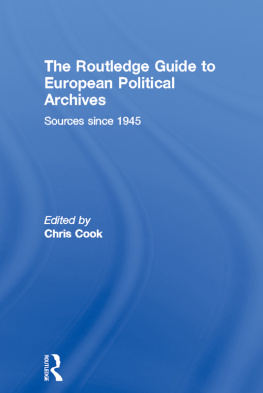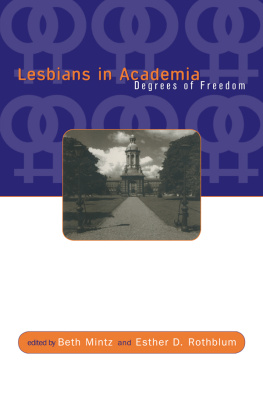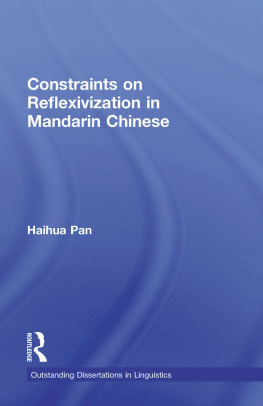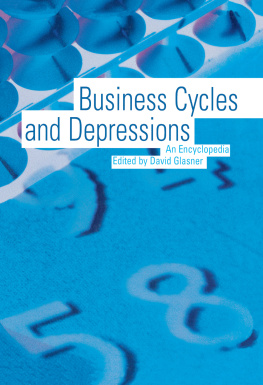
What happened where
Also by Chris Cook
The age of alignment: electoral politics in Britain, 1922-29
Sources in British political history, 1900-51 (6 vols, with Philip Jones et al.)
Britain in the Depression (with John Stevenson)
By-elections in British politics (ed. with John Ramsden)
European political facts, 1918-90 (with John Paxton)
British historical facts, 1830-1900 (with Brendan Keith)
The Longman atlas of modem British history, 1700-1970 (with John Stevenson)
The politics of reappraisal, 1918-39 (ed. with Gillian Peele)
Crisis and controversy: essays in honour of A. J. P. Taylor (ed. with Alan Sked)
European political facts, 1848-1918 (with John Paxton)
Post-war Britain: a political history (with Alan Sked)
The Longman handbook of modem British history, 1714-1995 (with John Stevenson)
The Labour Party (ed. with Ian Taylor)
Sources in European political history (3 vols, with Geoff Pugh et al.)
The Longman handbook of modem European history, 1763-1991 (with John Stevenson)
African political facts since 1945 (with David Killingray)
The Longman handbook of world history since 1914
Chris Cook & Diccon Bewes 1997
This book is copyright under the Berne Convention.
No reproduction without permission.
All rights reserved.
First published in 1997 by UCL Press
Reprinted 2004
by Routledge,
2 Park Square, Milton Park, Abingdon, Oxon, OX14 4RN
Transferred to Digital Printing 2004
The name of University College London (UCL) is a registered trade mark used by UCL Press with the consent of the owner.
British Library Cataloguing-in-Publication Data
A CIP catalogue record for this book is available from the British Library.
Library of Congress Cataloging-in-Publication Data are available
ISBNs: 1-85728-532-8 HB
1-85728-533-6 PB
Typeset in Plantin and Frutiger by The Studio, Exeter.
Contents
This work has attempted a rather different approach for those involved with the study and teaching of contemporary history in the twentieth century. It has aimed to assemble, within a concise volume designed as a helpful desktop companion, a wide-ranging guide to the places and events that have featured in twentieth-century world history. Hence this volume provides both teacher and student with concise and informative entries on the many hundreds of places of major historical significance. The entries are worldwide in scope ranging from Auschwitz to Pearl Harbor, from Tiananmen Square to Entebbe. There are many strands of history encompassed in this volume, from diplomatic crises (Agadir) to famous battles (Anzio, Ypres), from world conferences (Tehran) to scandals (Chappaquiddick), from massacres (Soweto) to assassinations (Sarajevo, Dallas).
The book has also attempted to provide the background information on the places behind the headlines. Thus conflicts over territory or disputed boundary claims have been at the origin of many modern wars. This volume not only provides a guide to such European disputes as the Sudetenland or the Saar, recent area conflicts in, for example, former Yugoslavia, but also worldwide areas of tension in Africa, the Middle East, Asia and Latin America. Cross-references in bold refer the reader to related entries.
An area of potential confusion for the student lies with the accelerated processes of decolonization after 1945, where the rise of African and Asian nationalism has led to the proliferation of new nation states. Old colonial names are now only halfremembered, their relationship to the new nations not always easily identifiable. Meanwhile the collapse of Communist rule in Eastern Europe and the former Soviet Union has spawned a host of new nations not familiar to the student. Not all national aspirations have yet been met. The history of the twentieth century has its quota of nations enjoying only brief independence (Biafra, for example, or the Basque homeland of Euzkadi) or indeed still fighting for independence (the Tamils or Kurds) as well as puppet states created in time of war (Manchukuo or Vichy).
In line with the growing emphasis on economic and social history, this volume includes names from the world of environment (Bhopal, Chernobyl, Three Mile Island), economic conferences (Bretton Woods) as well as names from the history of trade unionism (e.g. Taff Vale, Orgreave and Wapping in Britain). There are also cultural entries (ranging from Bloomsbury to Woodstock) and milestones in the gay and womens rights movement (the Stonewall Inn riot in New York, Tattenham Corner at Epsom). Some important religious places are also included. In chronological terms, the book covers the period from 1900 to the mid-1990s. In a few cases, entries prior to 1900 are included where their significance spills over into the twentieth century, as with Fashoda or Omdurman. Much coverage is given to contemporary events in the hope that this information will be of help to students of politics and current affairs as well as historians.
Inevitably this book has had to be selective. It has not attempted surveys of individual countries. The main exception is where a country, hitherto on the sidelines, is important for one major event (e.g. the civil war in Angola, the birth of Bangladesh, the missile crisis in Cuba). There is a brief guide to the changing nations of the century in gives a summary of the major conflicts of the period.
Very many people have helped in the preparation of this volume. I must particularly thank Andrew Rathmell for help on the Middle East, Harry Harmer for wide-ranging practical assistance and James Robinson for constant good advice. Ted Cater provided many suggestions for additional coverage of Latin America. I am also very indebted to John Stevenson for permission to use material in his copyright. For her secretarial help I am again indebted to Linda Hollingworth. At UCL Press my warmest thanks are due to Steven Gerrard. My very grateful thanks are due to my co-author, Diccon Bewes, for producing his part of the manuscript to an exacting deadline with unfailing good humour. Finally, I must thank Anne Mable for her long labours on the copy-editing of this manuscript.
Chris Cook
| ANC | African National Congress |
| ANZAC | Australia and New Zealand Army Corps |
| BEF | British Expeditionary Force |
| BJP | Bharatiya Janata Party |
| BUF | British Union of Fascists |
| CENTO | Central Treaty Organization |
| CGT | Confdration Gnrale du Travail (General Confederation of Labour) |
| CIA | Central Intelligence Agency |
| CIS | Commonwealth of Independent States |
| CND | Campaign for Nuclear Disarmament |
| CNT-FAI | Confederacin Nacional del Trabajo-Federacin Anarquista Iberia (National Confederation of Labour-Iberian Anarchist Federation) |
| CSCE | Conference on Security and Co-operation in Europe |
| EEC | European Economic Community |
| ELAS | Ethnikos Laikos Apeleutherotikos Straws (Hellenic Peoples Army of Liberation) |
| EOKA | Ethniki Organsis Kypriaku Agnos (National Organization of Cypriot Struggle) |







